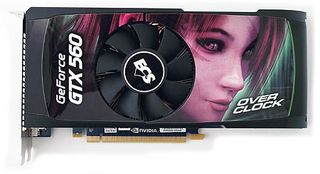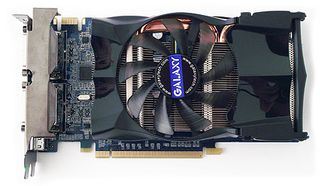Five Overclocked GeForce GTX 560 Cards, Rounded-Up
We were foiled in our quest to find the best vendor-provided GPU cooler for Nvidia's GeForce GTX 560. But out of the ashes sprung a round-up of cards armed with those very same solutions. Which of these five GF114-based boards is right for you?
Five Unique GeForce GTX 560s
Although the cooler comparison we had originally planned didn't quite work out, we were still able to use the submissions for a round-up of GeForce GTX 560 graphics cards.
With the ability to tweak core voltage on each of our five samples, we saw peak overclocks within 40 MHz of each other. The lowest overclock came from Zotac's AMP! card, which correspondingly had an unusually high temperature (by about 20 degrees under load). Even still, it scaled up to within 20 MHz of the other specimens. It seems reasonable, then, to expect Nvidia's GF114 GPU to land in the 1 GHz range if you're willing to put 1.15 V through it, no matter what cooler your vendor of choice uses.

Asus GTX 560 DirectCU II TOP
The Asus entry features solid construction, making it a great all-around offering. It boasts the second highest factory overclock amongst our contenders, the lowest idle noise, and moderate power draw in light of aggressive frequencies.
On the other hand, if you ask its fans to run at 100%, you're going to get unpleasant acoustics. Also, the company's price tag is on the high side given a lack of value-adds in the bundle. What you're paying for, then, is Asus' cooler, three-year warranty, and elevated clock rates.
At $220, this card doesn't represent the best value compared to other GeForce GTX 560 cards. However, the quality of its construction may warrant paying a little extra for folks satisfied with other Asus products.

ECSBlack Series NBGTX560-1GPI-F
Stay on the Cutting Edge
Join the experts who read Tom's Hardware for the inside track on enthusiast PC tech news — and have for over 25 years. We'll send breaking news and in-depth reviews of CPUs, GPUs, AI, maker hardware and more straight to your inbox.
This ECS card comes to the table with the lowest power draw, our second-lowest thermal reading, reasonably low acoustic output, and the highest attainable core overclock, though we suspect our sample was hand-picked. Nevertheless, ECS also gives us the lowest price tag. And, in a world where enthusiasts are happy handling their own tweaks, it's often worth paying as little as possible and extracting value the good-old-fashioned way.
Perhaps the worst thing we can say about ECS' submission is that its bundle is fairly bare. With that said, a lack of flashy extras is almost certainly responsible for enabling a sub-$200 price tag. And when every dollar counts, it's worth noting that game vouchers often go unused anyway.
Although there's a fair chance that your overclock won't be as fruitful as ours, ECS' effort here is sound. If you're looking for a low-cost GeForce GTX 560 to tinker around with, the NBGTX560-1GPI-F becomes an easy recommendation.

Galaxy 56NGH6DH4TTX GeForce GTX 560 MDT x4
The Galaxy MDT x4 card distinguishes itself from the rest of the field by enabling quad-display support using Nvidia's two independent display pipelines. One of the outputs operates on its own, while the others are ganged together using IDT's ViewXpand technology.
The good news is that you don't need special DisplayPort adapters like the ones required on most Radeon cards with Eyefinity support. The bad news is that because ViewXpand is driven by a single dual-link output, link rate limitations impose certain restrictions, like a 50 Hz refresh when you run three screens at 1920x1080.
Even still, the card performs well when it comes to power, thermal, and acoustic measurements. Moreover, despite its special functionality, it's also the smallest card, physically. As one of three cards able to reach or exceed 1 GHz with additional voltage applied, it's a capable overclocker too. Perhaps best of all, you pay a mere $10 premium over other overclocked cards like the Asus and Zotac models that lack the three- and four-screen support.
The principal reason you wouldn't want to spend that extra $10 is that a GeForce GTX 560 isn't beefy enough to play most demanding titles across three screens at 5760x1080. Although more mainstream or older games stand a better chance of running at playable frame rates, you'd get a better experience from two more powerful cards in SLI or CrossFire.
With that said, Galaxy's board is plenty capable gaming on one screen as you use three or four for productivity-oriented tasks.

MSI N560GTX Twin Frozr II/OC
MSI's Twin Frozr II/OC is another well-rounded card, offering the second-lowest power numbers, the lowest GPU temperature, minimal acoustic output, and the second-lowest price tag. At $199.99 it is again difficult to find fault with this model, especially considering that the company includes Lara Croft and the Guardian of Light in its bundle.
There's really not much else to add; we can't come up with anything to dissuade the value-conscious gamer from picking MSI's N560GTX Twin Frozr II/OC. It is, overall, a solid contender in a very competitive field of mid-range cards.

Zotac AMP! ZT-50702-10M GeForce GTX 560
Zotac's GeForce GTX 560 AMP! edition boasts the highest stock voltage setting and factory overclock in our test group. In fact, we can't find a GeForce GTX 560 running at higher frequencies. That alone might be sufficient reason for some enthusiasts to shell out the $220 bucks this board commands (particularly if you can't be bothered to overclock manually). Additionally, the board includes a good game choice: Assassin's Creed: Brotherhood.
Unfortunately, the cooler on our test sample didn't perform as well as we would have hoped, and was louder than competing cards under load. Along with this, we saw higher temperatures and power usage. In fact, the results were "off" enough to make us wonder if the GPU cooler was properly seated. We disassembled the card and found everything installed properly from the factory. This was backed up by consistent numbers that didn't change after putting the card back together. We checked with Zotac before publishing our findings and were told that the issue is likely related to the firmware that shipped with a number of early samples.
Update: We just received an updated firmware and will add our results with it as soon as possible.
Slightly higher power consumption and elevated temps might not be show-stoppers for enthusiasts gunning for the highest possible overclock. However, the acoustics are more problematic. It is also worth noting that Zotac is the only manufacturer in this round-up that offers a limited lifetime replacement warranty if the product is registered within 30 days of purchase. This extra warranty is only offered in the US.
Current page: Five Unique GeForce GTX 560s
Prev Page Power, Temperature, And Noise-
pensivevulcan Kepler is around the corner, so are lower end AMD 7000 series parts, this was interesting but wouldn't one want to wait for a plethora of reasons.Reply -
payneg1 The Galaxy model comes closest with its 830/1002 MHz clocks, but Zotac's AMP! edition goes all the way to 950/1100 MHz.Reply
This dosent match with the above chart -
crisan_tiberiu so, basicaly if someone plays on a single monitor, there is no point going beyond a gtx 560 or a 6950 in today's games. (it slike in the "best gaming CPU chart", no point going beyond i5 2500k for gaming.Reply -
giovanni86 salad10203Are those temps for real? My 280 gtx has never idled under 40C.Your kidding right, my overclocked 580GTX at 60% fan speed idles at 32c. Cards down clock themselves which allows them to run cooler at idle temps even if it were clocked at upwards i don't think a card would get hot unless it was being used.Reply -
justme1977 crisan_tiberiuReply
I have the feeling that even a i5 2500k@4ghz bottlenecks a 7970 @1080p in most newer games.
If the GPU market goes the way it does, it won't take long that even midrange cards will be bottlenecked @1080p by the cpu.
-
FunSurfer I think there is an error on the Asus idle voltage: instead "0.192 V Idle" it should be 0.912Reply
Most Popular

